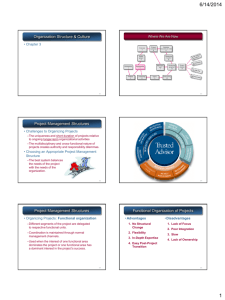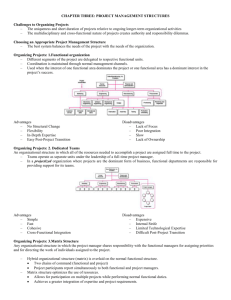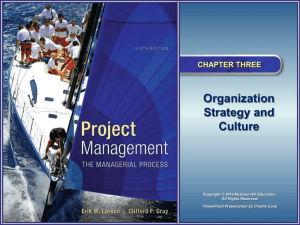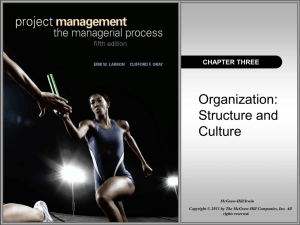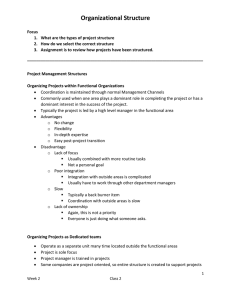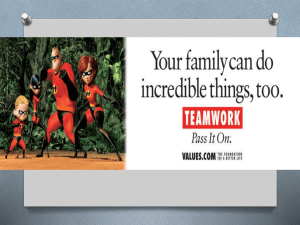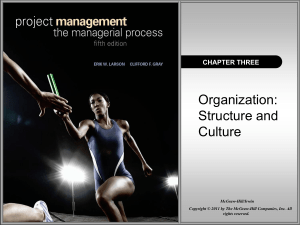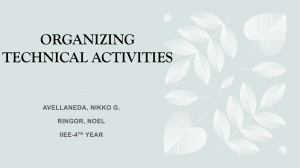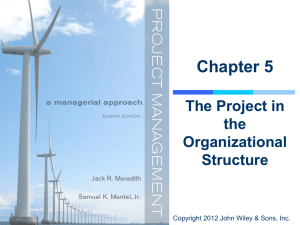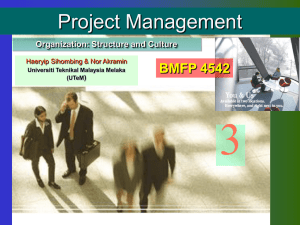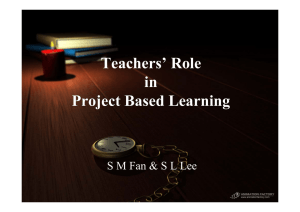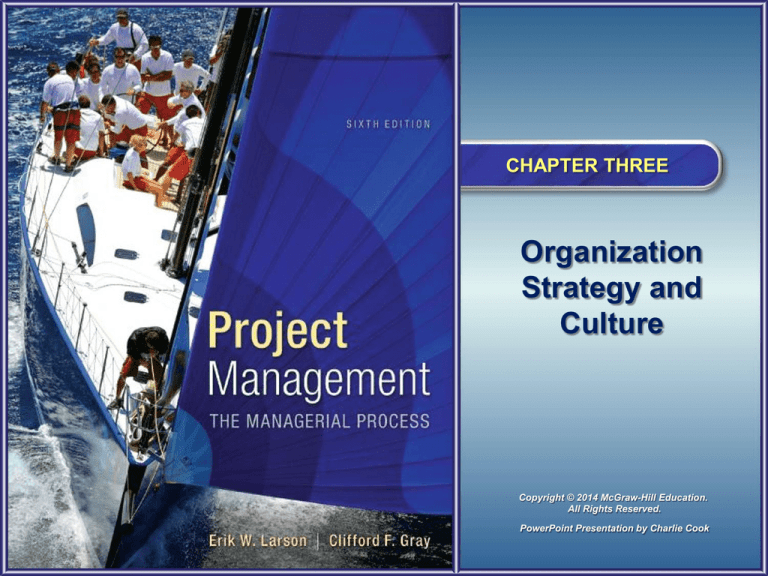
CHAPTER THREE
Organization
Strategy and
Culture
Copyright © 2014 McGraw-Hill Education.
All Rights Reserved.
PowerPoint Presentation by Charlie Cook
Where We Are Now
3–2
Project Management Structures
• Challenges to Organizing Projects
– The uniqueness and short duration of projects relative
to ongoing longer-term organizational activities
– The multidisciplinary and cross-functional nature of
projects creates authority and responsibility dilemmas.
• Choosing an Appropriate Project Management
Structure
– The best system balances
the needs of the project
with the needs of the
organization.
3–3
Project Management Structures (cont’d)
• Organizing Projects: Functional organization
– Different segments of the project are delegated
to respective functional units.
– Coordination is maintained through normal
management channels.
– Used when the interest of one functional area
dominates the project or one functional area has
a dominant interest in the project’s success.
3–4
Functional Organization of Projects
• Advantages
1. No structural
change
2. Flexibility
3. In-depth expertise
• Disadvantages
1. Lack of focus
2. Poor integration
3. Slow
4. Lack of ownership
4. Easy post-project
transition
3–5
Project Management Structures (cont’d)
• Organizing Projects: Dedicated Teams
– Teams operate as separate units under the
leadership of a full-time project manager.
– In a projectized organization where projects are the
dominant form of business, functional departments
are responsible for providing support for its teams.
3–6
Project Organization: Dedicated Team
• Advantages
• Disadvantages
1. Simple
1. Expensive
2. Fast
2. Internal Strife
3. Cohesive
3. Limited Technological
Expertise
4. Cross-Functional
Integration
4. Difficult Post-Project
Transition
3–7
Project Management Structures (cont’d)
• Organizing Projects: Matrix Structure
– Hybrid organizational structure (matrix) is overlaid on
the normal functional structure.
• Two chains of command (functional and project)
• Project participants report simultaneously to both functional
and project managers.
– Matrix structure optimizes the use of resources.
• Allows for participation on multiple projects while performing
normal functional duties.
• Achieves a greater integration of expertise and project
requirements.
3–8
Different Matrix Forms
• Weak Form
– The authority of the functional manager predominates
and the project manager has indirect authority.
• Balanced Form
– The project manager sets the overall plan and the
functional manager determines how work to be done.
• Strong Form
– The project manager has broader control and
functional departments act as subcontractors
to the project.
3–9
Project Organization: Matrix Form
• Advantages
• Disadvantages
1. Efficient
1. Dysfunctional Conflict
2. Strong Project
Focus
2. Infighting
3. Easier Post-Project
Transition
3. Stressful
4. Slow
4. Flexible
3–10
What Is the Right Project
Management Structure?
• Organization (Form) Considerations
– How important is the project to the firm’s success?
– What percentage of core work involves projects?
– What level of resources (human and physical)
are available?
3–11
What Is the Right Project
Management Structure? (cont’d)
• Project Considerations
– Size of project
– Strategic importance
– Novelty and need for innovation
– Need for integration (number of departments
involved)
– Environmental complexity (number of external
interfaces)
– Budget and time constraints
– Stability of resource requirements
3–12
Organizational Culture
• Organizational Culture Defined
– A system of shared norms, beliefs, values, and
assumptions which bind people together, thereby
creating shared meanings.
– The “personality” of the organization that sets it
apart from other organizations.
• Provides a sense of identify to its members.
• Helps legitimize the management system of the organization.
• Clarifies and reinforces standards of behavior.
3–13
Identifying Cultural Characteristics
• Study the physical characteristics
of an organization.
• Read about the organization.
• Observe how people interact
within the organization.
• Interpret stories and folklore
surrounding the organization.
3–14
Key Terms
Balanced matrix
Dedicated project team
Matrix
Organizational culture
Projectized organization
Project Office (PO)
Strong matrix
Weak matrix
3–15

